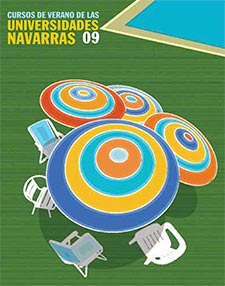BRINGING THE HERITAGE CLOSER. ESTELLA, ART AND THE ROAD
28 August 2009
reportIdentity and image of Estella in the plastic arts of the 19th and 20th centuries.
Mr. José Javier Azanza López. Chair of Navarrese Heritage and Art.
Countless artists of the 19th and 20th centuries, sculptors and painters, photographers and engravers, have left testimony through their works of the history and characters of the city of Estella, of its customs and traditions, of its monumental buildings, streets and squares.
The mark of the report has been captured in the memory of historical events and characters, including the last Carlist War, the royal visits of Alfonso XIII, or the commemoration of the IX Centenary of the Fueros of the city, in the monument of the sculptor Manuel Clemente Ochoa from Cascantino. Another sculptor from Navarre, Fructuoso Orduna, from Roncal, conceived in 1924 a monument to Fray Diego de Estella that was never executed.

Manuel Clemente Ochoa. Monument to the IX Centenary of the Fueros
The identity of the city remains alive in its customs and traditions. This is the case of the Estella washerwomen, a typical image of the first decades of the 20th century on the banks of the Ega River and a source of inspiration for many painters and photographers, among them Gustavo de Maeztu and Eustasio Villanueva from Burgos. Or the fairs and markets, an activity closely linked to the city since its origins, which have been so well captured by the brushes of Jesús Basiano and Eugenio Menaya or the photographic camera of Nicolás Ardanaz. A sign of identity is also the figure of the auroro, whose monument in Estella becomes a tribute to Adriano Juániz and to the very roots of the city.
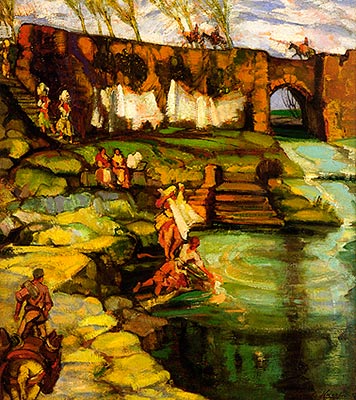
Gustavo de Maeztu. San Juan Bridge
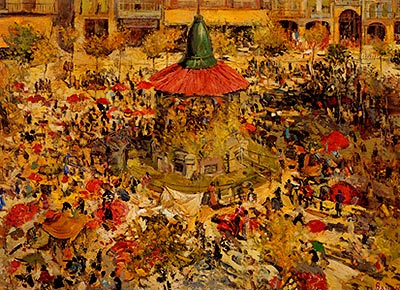
Jesus Basiano. Estella Market, 1950-55
The image of Estella is reflected in the landscape of the city and its natural surroundings: the monumental medieval churches of San Miguel and San Pedro de la Rúa, the narrow and attractive alleys that make up its hamlet, the squares and promenades that host human activity; or the solemnity of Montejurra that dominates and protects it, the leisurely course of the Ega River, and the vicinity of the Lóquiz mountain range, all this wealth is offered to painters and photographers who have been able to capture their vision staff of the city. The landscape of Estella is thus captured in the nuanced chromatism of Jesús Basiano, in the expressive force of the passionate impasto of Florentino Retana, and in the atmosphere of remoteness and silence of Pedro Salaberri. In the luminosity and post-impressionist synthesis of Fernando de Amárica, in the Cezannian geometry of Gaspar Montes Iturrioz, and in the abundance of nuances and symphony of atmospheres of Joaquín Ilundáin. In the strong and energetic brushstroke of Jesús Lasterra, in the refined and intimate lyricism of Francisco Bengoa, and in the vigorous and consistent interpretation of José María Ascunce. In the chromatic sense of Inocencio García Asarta, in the humanized landscape of Pedro Lozano de Sotés, and in the clean and crystalline atmosphere of César Muñoz Sola. Finally, Estella also appears to us through the goal of photographers such as José Ortiz-Echagüe, the Marquis of Santa María del Villar, Pedro Ledesma, Asenjo or the Laurent y Cía Society, all of whom captured the city's monuments and places of interest with their cameras.

Florentino Retana. Estella from the cross of the castles
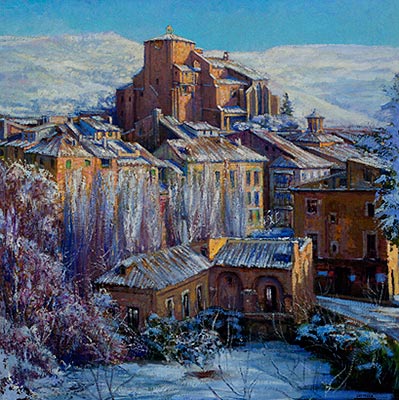
Jesús Lasterra. Estella in winter, 1963
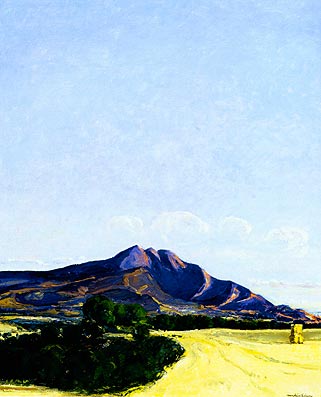
Joaquín Ilundáin. Montejurra. 2004
PROGRAM
TUESDAY, AUGUST 25
The splendor of Estella in the Renaissance. Art and Artists
Ms. María Concepción García Gainza. Chair of Navarrese Heritage and Art.
Image of God, image of man: the façade of San Miguel de Estella
Mr. Javier Martínez de Aguirre Aldaz. Complutense University of Madrid
San Pedro de la Rúa: styles and interstyles in a medieval building.
D. Carlos J. Martínez Álava. I.E.S. "Pedro de Ursua" of Pamplona
WEDNESDAY, AUGUST 26TH
Following in the footsteps of the Gothic in Estella: Santo Sepulcro and Santo Domingo
Ms. Santiaga Hidalgo Sánchez. Chair of Navarrese Heritage and Art.
Estella's movable heritage
Ms. Mercedes Jover Hernando. Chair of Navarrese Heritage and Art.
A city born for the Camino. visit guided tour of the city of Estella
D. Román Felones Morrás. Full Professor of Geography and History of the I.E.S. Tierra Estella.
THURSDAY, AUGUST 27TH
Architecture and Humanism in Estella in the 16th century.
Mrs. María Josefa Tarifa Castilla. Chair of Navarrese Heritage and Art.
Traces of the Baroque in Estella
Ms. Pilar Andueza Unanua. Chair of Navarrese Art and Heritage.
The sumptuary arts in Estella: from the Age average to the 19th century.
D. Ignacio Miguéliz Valcarlos. Chair of Navarrese Heritage and Art.
FRIDAY, AUGUST 28TH
Images of a conflict. Estella and the last Carlist War
D. Ignacio Jesús Urricelqui Pacho. Chair of Navarrese Heritage and Art.
reportIdentity and image of Estella in the plastic arts of the 19th and 20th centuries.
Mr. José Javier Azanza López. Chair of Navarrese Heritage and Art.
Museum and city. Gustavo de Maeztu and Estella
D. Gregorio Díaz Ereño. Director of the Jorge Oteiza Museum.
Closing

